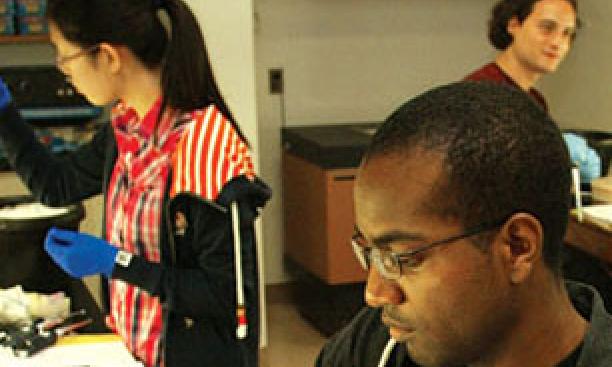

In the fall of 2007, Liz Johnson, a senior biology major at Spelman College in Atlanta, knew where she wanted to attend graduate school: Harvard or Vanderbilt.
But a visit to Spelman by Princeton staff and faculty, including genomics institute director David Botstein, began a series of contacts with professors that led to Johnson’s arrival at Princeton the following year.
The Princeton group listened as Johnson presented her honors thesis research. “The interactions I had with the faculty really got me excited about attending graduate school at a place that had so many resources,” said Johnson, a fourth-year molecular biology Ph.D. candidate who is a former president of the Black Graduate Caucus.
At a time when the graduate school is emphasizing diversity, initiatives by two programs — molecular biology and quantitative and computational biology (QCB) — are drawing attention for their results in recruiting underrepresented minorities (Hispanic, black, and Native American students).
The impact is shown by statistics that look at entering Ph.D. students in molecular biology, QCB, and the year-old neuroscience program compared with the previous five-year period (when all were part of molecular biology). Underrepresented minority applicants increased from an average of 13 to an average of 41 per year; the number admitted increased from about four to 15 per year; and the average number accepting admission jumped from fewer than one to six per year.
Overall, the average percentage of underrepresented minority students in each entering class increased from just 3 percent in the 2003–07 period to 24 percent in 2008–11, which the department said is above the percentage for college biology majors nationally.
Though the graduate school has put staff and money into recruiting talented minority students, the ratio of underrepresented minority students to all enrolled students has remained about half of the same ratio for Princeton undergraduates. Over the last five years, underrepresented minorities at the grad school have made up between 8.5 and 13.5 percent of incoming U.S. students. This year’s entering class includes 53 black, Latino, and Native American students, up from 33 last year. The yield was up sharply, from 46 to a record 72 percent.
What those numbers don’t show, said William Russel, dean of the graduate school, is the increasing quality of minority applicants. Five to 10 years ago, few underrepresented minority applicants were among the students recommended most highly by departmental committees for admission, he said; today, they often are.
At the same time, Russel said, the degree-completion rate is more consistent for minority graduate students than in the past, reflecting the impact of professional-development programs spearheaded by Karen Jackson-Weaver ’94, associate dean for academic affairs and diversity.
The key to success of diversity efforts is to keep building faculty attention and support, Russel said. That’s echoed by Lynn Enquist, chairman of the molecular biology department, who said “the old system doesn’t work.” What’s needed, he said, is to “get out of Princeton, get off your computer, and get into the undergrad schools with diverse populations.”
The diversity program that serves molecular biology and QCB was created in 2007, with senior lecturer Alison Gammie chosen as director. At the time, University funding from the National Institutes of Health that supported about 28 training slots for grad students was up for renewal, and the NIH was “exerting pressure to increase the diversity,” Gammie said. The department’s plan to increase diversity in the biology programs, backed by funding that Botstein helped to secure, cleared the way for the grant’s renewal.
“The bottom line is that the government made clear what we already knew — that the University had a moral obligation to do better,” Botstein said.
The diversity program set out to increase applications from minority students, improve the matriculation rate, and provide support and mentoring to ensure the success of admitted candidates.
Among the initiatives were strategic recruiting and establishing long-term relationships with minority-serving institutions such as Spelman and Morehouse colleges; admission decisions that rely more on letters of recommendation, research experience, and stated “passion for research”; offers to waive admission fees; expanding minority participation in a popular Princeton summer research program for undergraduates; and creation of a summer course for incoming students called MOL500, taught by Gammie and focused on the research culture and skills for success in graduate school.
“You can transform a department,” Gammie said. “It’s important to have a diversity of viewpoints and perspectives in science, and by actively recruiting students who reflect the general population, it can be done.”
